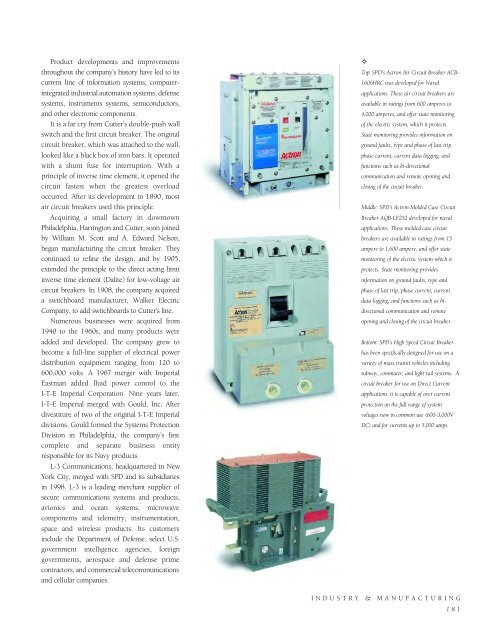Historic Philadelphia
An illustrated history of the city of Philadelphia, paired with the histories of companies, families and organizations that make the region great.
An illustrated history of the city of Philadelphia, paired with the histories of companies, families and organizations that make the region great.
You also want an ePaper? Increase the reach of your titles
YUMPU automatically turns print PDFs into web optimized ePapers that Google loves.
Product developments and improvements<br />
throughout the company’s history have led to its<br />
current line of information systems, computerintegrated<br />
industrial automation systems, defense<br />
systems, instruments systems, semiconductors,<br />
and other electronic components.<br />
It is a far cry from Cutter’s double-push wall<br />
switch and the first circuit breaker. The original<br />
circuit breaker, which was attached to the wall,<br />
looked like a black box of iron bars. It operated<br />
with a shunt fuse for interruption. With a<br />
principle of inverse time element, it opened the<br />
circuit fastest when the greatest overload<br />
occurred. After its development in 1890, most<br />
air circuit breakers used this principle.<br />
Acquiring a small factory in downtown<br />
<strong>Philadelphia</strong>, Harrington and Cutter, soon joined<br />
by William M. Scott and A. Edward Nelson,<br />
began manufacturing the circuit breaker. They<br />
continued to refine the design, and by 1905,<br />
extended the principle to the direct acting limit<br />
inverse time element (Dalite) for low-voltage air<br />
circuit breakers. In 1908, the company acquired<br />
a switchboard manufacturer, Walker Electric<br />
Company, to add switchboards to Cutter’s line.<br />
Numerous businesses were acquired from<br />
1940 to the 1960s, and many products were<br />
added and developed. The company grew to<br />
become a full-line supplier of electrical power<br />
distribution equipment ranging from 120 to<br />
600,000 volts. A 1967 merger with Imperial<br />
Eastman added fluid power control to the<br />
I-T-E Imperial Corporation. Nine years later,<br />
I-T-E Imperial merged with Gould, Inc. After<br />
divestiture of two of the original I-T-E Imperial<br />
divisions, Gould formed the Systems Protection<br />
Division in <strong>Philadelphia</strong>, the company’s first<br />
complete and separate business entity<br />
responsible for its Navy products.<br />
L-3 Communications, headquartered in New<br />
York City, merged with SPD and its subsidiaries<br />
in 1998. L-3 is a leading merchant supplier of<br />
secure communications systems and products,<br />
avionics and ocean systems, microwave<br />
components and telemetry, instrumentation,<br />
space and wireless products. Its customers<br />
include the Department of Defense, select U.S.<br />
government intelligence agencies, foreign<br />
governments, aerospace and defense prime<br />
contractors, and commercial telecommunications<br />
and cellular companies.<br />
✧<br />
Top: SPD’s Actron Air Circuit Breaker ACB-<br />
1606HRC was developed for Naval<br />
applications. These air circuit breakers are<br />
available in ratings from 600 amperes to<br />
4,000 amperes, and offer state monitoring<br />
of the electric system, which it protects.<br />
State monitoring provides information on<br />
ground faults, type and phase of last trip,<br />
phase current, current data logging, and<br />
functions such as bi-directional<br />
communication and remote opening and<br />
closing of the circuit breaker.<br />
Middle: SPD’s Actron Molded Case Circuit<br />
Breaker AQB-LF252 developed for naval<br />
applications. These molded case circuit<br />
breakers are available in ratings from 15<br />
ampere to 1,600 ampere, and offer state<br />
monitoring of the electric system which it<br />
protects. State monitoring provides<br />
information on ground faults, type and<br />
phase of last trip, phase current, current<br />
data logging, and functions such as bidirectional<br />
communication and remote<br />
opening and closing of the circuit breaker.<br />
Bottom: SPD’s High Speed Circuit Breaker<br />
has been specifically designed for use on a<br />
variety of mass transit vehicles including<br />
subway, commuter, and light rail systems. A<br />
circuit breaker for use on Direct Current<br />
applications, it is capable of over current<br />
protection on the full range of system<br />
voltages now in common use (600-3,000V<br />
DC) and for currents up to 5,000 amps.<br />
INDUSTRY &<br />
MANUFACTURING<br />
181
















